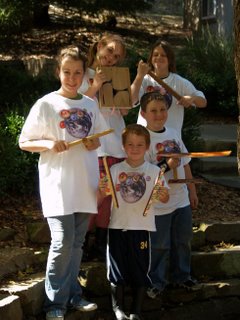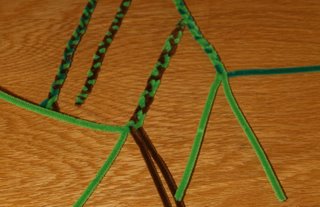On the challenge ahead... Many of the people reading this blog (I know there are at least a few) would already have some sense of the role the hands play in learning. The world at large, however, even the world of educators, is nearly oblivious. I was reminded of the challenge at hand when Laura Waters, the Rogers Arkansas art teacher gave me some feedback recently on her newly created woodworking program. There were some complaints from other teachers about the noise of children hammering, and the sawdust generated by their work. There may be some legitimacy to the complaints and some effort may be required to fix things, but there are also those who will complain about anything new, anything different, and anything that disrupts their comfort or threatens their deeply engrained views of education. There is also the "not invented by me" complex that can lead to nay-saying and resistance.
It is extremely difficult to make changes in established institutions, whether we are talking about government, large corporations, school districts or schools.
In order to get hands-on education re-established in our nation's schools, it is extremely important to know clearly the challenge we face, and recognize the long-term and steady engagement that will be required.
Today, I want to talk about strategy. In some schools now, there is a renewal of interest in vocational education, preparing students for jobs that don't require college. This is a wonderful trend. College is not the best choice for all students, and there are many non-college employment opportunities that can lead to a wonderful life, successful careers and responsible citizenship. But is the renewal of vocational programs enough?
In 1903, Otto Salomon, director of the Sloyd teacher seminarium in Nääs stated the following: "I see a system as a casting mould---necessary during the process of casting but that ought to be thrown away and dismantled when the work–of-art has been cast. I believe that the so-called Nääs-system” has had its day; it is in the past, not in the present, still less in the future. While most of the principles have become so universal that they are stated to be self-evident, even by persons who certainly would not like to promote anything that comes out of Nääs, and there is no further need for a Nääs-system in the domain of manual training."
In retrospect, Salomon was mistaken. While manual training had made major inroads into education, the principles of Sloyd had not. The continuous failure to recognize the significant role of the hands in learning is tragic for all children whether preparing for vocational school, college, or just life.
Many see the restoration of vocational training in high schools to be enough, but the real challenge is to foster a new understanding of the role of the hands and their power through the application of the arts to shape scientific understanding and awareness.
So strategy...How do we do it? How do we restore the role of the hands in learning and education? One objective is for those of us who work with our hands to watch and take notice of their engagement in consciousness. With what we have learned, we must then take the time to create learning opportunities for others. Don't expect the schools to do it for you. They won't yet. If you are a parent or grandparent, cook with your children. Make things. Start a garden. Do real things that will engage your children's hearts and minds through the movement of their hands.
While we are working at the most personal levels, there are those who are working to bring a renewed scientific understanding of the role of the hands in learning. The evidence is beginning to mount. Don't be shy about adding your own voice to the choir.
Barbara Stafford from the University of Chicago just sent me information about her new book
Echo Objects: The Cognitive Work of Images She tells me that my work with learning through the hands is mentioned in it, so, of course I'm curious what she says. The blurb on the book is as follows: "
Echo Objects: the Cognitive Work of Images is a spectacular effort of thinking outside discipline boundaries, a sort of interdenominational bible of arts and neuroscience." With allies in academia like Barbara Stafford, those of us who find meaning in our hands, in the making of objects, can be assured of the value and relevance of our own observations and move ahead confidently with the education of those around us.
 grandiloquence n. -"a pompous or lofty manner of speaking or writing."
grandiloquence n. -"a pompous or lofty manner of speaking or writing."  It is made with a leather hinge based on a children's toy called a "jacob's ladder." The rabbett joint corners are locked with dowels. A DVD of the same title as shown in the image at left will also be available. It ilustrates a wide range of basic box making techniques based on my 30 years of box making experience. Both are scheduled for a January 30, 2007 release date. Happy New Year! This is my last post of 2006! May the coming year bring great things to you.
It is made with a leather hinge based on a children's toy called a "jacob's ladder." The rabbett joint corners are locked with dowels. A DVD of the same title as shown in the image at left will also be available. It ilustrates a wide range of basic box making techniques based on my 30 years of box making experience. Both are scheduled for a January 30, 2007 release date. Happy New Year! This is my last post of 2006! May the coming year bring great things to you.



























